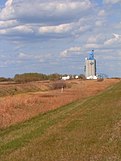Portal:Agriculture/Selected article/27
Canada is one of the largest agricultural producers and exporters in the world. As with other developed nations, the proportion of the population and GDP devoted to agriculture fell dramatically over the 20th century but it remains an important element of the Canadian economy.
A wide range of agriculture is practiced in Canada, from sprawling wheat fields of the prairies to summer produce of the Okanagan valley. In the federal government, overview of Canadian agriculture is the responsibility of the department of Agriculture and Agri-Food.
Agriculture in Canada comprises five main agricultural production sectors of commodity production resulting in farm cash receipts from both domestic and foreign markets.
Horticulture which includes garden crops, and fruits became easier to grow with the development of plant hardiness zones.
Apples, pears, plums and prunes, peaches, apricots, cherries, strawberries, raspberries, loganberries and fruit orchards are numerous and reach commercial size in the Annapolis Valley of Nova Scotia, New Brunswick, Quebec, Niagara Peninsula and Norfolk County of Ontario and Okanagan Valley of British Columbia.
Hazelnuts are harvested in Eastern Canada and British Columbia. Maple syrup and maple sugar, maple butter, and maple taffy are products of Quebec along the St. Lawrence River. The main market for Canadian maple syrup and sugar is the United States. Potatoes are an abundant harvest of the Maritime provinces. Sugar beets and beet root sugar are harvested in Quebec, Ontario, Manitoba, and Alberta.
115,000 cattle roamed the southern prairies by 1900. Livestock can include the raising of cows, also commonly called cattle. Recently domestication of the buffalo and elk has initiated a new food industry. Sheep have been raised for both wool and meat. Bovine or pig barns have been a part of livestock culture. Scientists have been making forward steps in swine research giving rise to intensive pig farming. The domestication of various farm animals meant that corresponding industries such as feedlots, animal husbandry and meat processing have also been studied, and developed. (Full article...)

